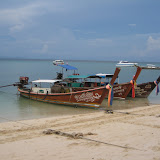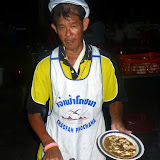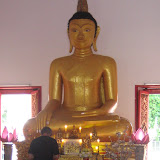Night sounds swallow our ears as we walk back to our hotel room in Hat Surin, Phuket. It rained for a while this afternoon, and suddenly a bellicose chorus of frogs competes for the chance to be heard. It’s not a frog choir like I remember in Olympia where Pacific Treefrogs ribbet politely one after the other. These Thai frogs ‘vrooom,’ sounding like horns calling at a Hindu temple, with layered deep bass tones one over the other, each droning 4 to 5 seconds. In Phnom Penh, we heard Cambodian frogs, no doubt cousins of these Thai hoppers, but there the frogs had shorter tones and did not blurt so forcefully. The frogs in Cambodia were black. Here the frogs are almost invisible, but I have spotted some with bright green lines. They don’t look large enough to orchestrate the full sounds we hear as we walk along the gardenia-scented pathway to our room.
An Amphibian Scale
Listening closely, I try to determine the notes. They seem like D and F in Thailand, whereas in Cambodia I was sure it was a low B flat. The motifs seem to compliment music we have heard on this trip. It makes me wonder how much the musical scale in Asia has been influenced by amphibians in the night. A pentatonic 5-tone scale is used in Thailand, Cambodia and China for classical music, and sometimes the 7-tone heptatonic is used as well. This music is passed down in the oral tradition. There are written scores, but apparently, one must be taught by a learned music scholar to decipher the notations.
Historically, pentatonic scales were also used by the Incas, American Indians, Chinese, Russians, in India, in Africa, in Tibet, and in hymns of Europe and the US, as well as by Dvoark and Debussy.
During the Cultural Revolution in China, and during the Pol Pot Regime in Cambodia, many classical performing artists were deprived of their music. Because these instruments are taught in an oral tradition, and because historically they were mastered not merely for performance but for spiritual renewal, current musicians report that there is perhaps a generational gap in both appreciation and practice of sacred musical art.
How I Played the Erhu
Poorly. But at least I had a chance. As Don and I explored the Temple of Heaven in Beijing, I spent some time observing a Chinese man instructing a woman on erhu (or Er-hu) technique. They were seated on a cement balustrade, shaded in the midst of a fragrant garden, while other Chinese picnicked or played board games alongside. I drew close to examine the erhu instrument and the printed music on the stand, as the instructor corrected the student during her lesson. The bowed two-stringed erhu instrument, a relative of the violin, first originated in the Tang dynasty (618-907) and is made of ebony, sandalwood and SNEK skin (see my previous China entry on SNEKS.) Crimoney, had I known I wouldn’t have touched it! But, it had the most intriguing sound, and I saw that the bamboo and horsehair bow scraped low on the soundbox of the body where it automatically passed over a thick chunk of rosin each time. With this instrument, one would never have to put rosin on the bow! It looked so exotic.
I must have stared too hard. Before I knew it, the instructor indicated I should sit on the edge of the railing and soon he was positioning my hands on the instrument and the fragile bow. The bow is held with different fingers than a violin or viola bow, and it seems less able to be controlled because it is lightweight and short. Quickly he also placed my left hand on the neck of the strings, with the instrument’s belly in my lap, held as though it were a western cello. The erhu’s strings, I discovered, do not press upon a fingerboard and there are no frets, but instead, the artist must slide the fingers around with nothing to push against to make the pitches. I swallowed hard and began to haltingly bow and finger the erhu. The resulting squawk was hopeless, so the instructor grabbed the erhu away from me and re-demonstrated how to push on the two strings and how to bow….then he let me have a second try. I concentrated very hard and was barely able to play in pitch---do-re-mi-fa-so…but then I did not know how to move on up the scale or how to access the second string. I believe that the bow might be two sided, and that in order to play the second string, I needed to have angled it the opposite direction. But who cared, because all those around (yes, a crowd had gathered to watch my debut) were cheering, delighted that I could scritch out a few pathetic notes in relative pitch. As I laughed triumphantly, I sang to them, spontaneously performing ‘do re mi fa so la ti do’, trying to demonstrate that I knew which notes should come next. Immediately both the instructor and student echoed back ‘do re mi fa so la ti do.’ We could communicate! Suddenly, we all understood one another in the language of music. I explained through body language that I could play the violin (or viola), demonstrating my imaginary viola with immaculate position and gusto, to which they nodded and bowed. (bowed as in bending at the waist, not as in bowing an instrument…I see this is very complicated to explain!)
Just Horsing Around
Many other cultures have versions of the erhu. The Thai call their 2-stringed violin the saw duang. Apparently in Thai music, it is used heterophonically, only in unison; there are no harmonies. I have learned that there is actually a Chinese viola form of the erhu, called the zhong-hu. It is the mid-pitched voice of the instrument, and certainly would sound more luscious than the erhu, as any violist knows. In the Chinese, Cambodian and Thai cultures, these string instruments are the mainstay of classical operas and used to play the melody, and also to imitate the sounds of horses and birds. I believe that my playing was a good example of at least the sound of a horse.
Playing the erhu was exhilarating, even better than winning first chair. As I departed the teaching site, I lowered my head and bowed low to thank my instructor for the lesson. We all smiled as the dethroned student reclaimed her instrument, and then with a gloating smile plastered across her face, demonstrated at forte a complete and magnificent scale to me, octave to octave. I nodded back, suitably humbled.
Much later as Don and I ambled back to our Beijing hotel, we passed by an old man playing erhu on the sidewalk. His eyes were closed as he performed a longing and plaintive melody, beautifully articulated. I could not help but stop and gaze at him with utmost envy and respect.
*********************************************************************************
DV Thailand TravelVlog
We flew from Phnom Penh to the Bangkok airport and then to Phuket. We'll be back to The Bangkok airport again on our way out of Thailand heading to Egypt in 2 ½ weeks. Along the way, we reluctantly canceled our brief visit to Bangkok based on our best information about the violence, the city being locked down, etc. A shame but the beaches of Thailand await us:Phuket is a large island in Southern Thailand that is blessed with beautiful beaches and coral reefs and cursed with the massive tourism effect that has subsequently taken over, and at least one major recent tsunami [26 Dec. 2004] We spent a few days relaxing, beach walking and exploring.
{Click on the picture to access the web album, then the back browser arrow to return to our Vlog!]
{Click on the picture to access the web album, then the back browser arrow to return to our Vlog!]
Then off to Ko Phi Phi Don [love that name], commonly referred to as Phi Phi islands [pronounced Pee Pee islands.] and includes Ko Phi Phi Leh, the little island south of the larger Phi Phi Don. The town in the center of Phi Phi Don was devastated by the tsunami, but has made more than a substantial comeback. Everywhere on the island is accessible only by boat. There are no roads or cars. We stayed a few days at a place that was a cross between camping and super nice resort. The snorkeling was fabulous right out our door but we also did two dives off of Phi Phi Leh that were incredible. The coral, fish, colors, clarity, etc, etc. I felt like I was in a real-life Avatar adventure floating through the wildest scenery ever. Click on us to see our only decent underwater picture!
The beauty underwater would have been breathtaking, but at 17 meter depth one can't really gasp without causing a serious SCUBA malfunction.
More pics of Ko Phi Phi Don:
| Thai Avatar |
More pics of Ko Phi Phi Don:
 |
| Ko Phi Phi Don and Leh |
I have fallen in love with the long-tail boats here and Cambodia. Long narrow wooden boats hand-made on the beaches. They efficiently cut through the water, have large uncovered, hand-crank starting engines with a long shaft to a forward only 2 blade prop. Here are a few images:
From Phi Phi we long-tail boated and then ferried and then long-tail boated and then waded in to the beaches of Rai Leh or Railay—spectacular cliffs and crags and once again I got that Avatar feeling. We have hiked and kayaked here. Railay itself has spectacular beaches but is cut off from the rest of the mainland because of the towering cliffs around it. It's like being on an island:
 |
| Long-tail boats |
 |
| Railay |
Foods, flora, and fauna in Thailand:
Lots of potential for such great eating, the fruits, especially are amazing. I've put in just a few shots of some of the flowers, animals and some food in this album but, of course, they are also in every album!
Lots of potential for such great eating, the fruits, especially are amazing. I've put in just a few shots of some of the flowers, animals and some food in this album but, of course, they are also in every album!
 |
| Flora, food & fauna in Thai |
Getting Krabi:
Railay, and even the Phi Phi islands are part of Krabi province which is West coast on the lower Thai Peninsula. For now we will long-tail over to the to Krabi Town for some good night market food:
And then a bus and ferry to the island of Ko Samui. It's time to say good-bye to Thailand. Tomorrow, Egypt. Wait, I think I can see it from here...........
 |
| Krabi |
Stay tuned!






